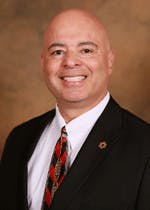EHS Today reached out to a number of EHS leaders to discover their perspective regarding EHS trends and developments that will impact the practice of EHS and worker safety in 2018 and beyond. Here is what they had to say:
Fay Feeney, CSP, ARM, ASSE Fellow
Innovation and disruption arising from technological innovation has not been distributed equally across all industry sectors. This is a new time with a “disrupt or be disrupted” environment. New ways to contribute to protecting workers need to be challenged as we seek to innovate.
Social impact includes a new emphasis on sustainability, a broad range of issues from environmental concerns to a focus on human capital operating safely to succeed in the future. This shift allows EHS to position investments for improvement and align management with the future.
Corporate culture is an off-balance sheet asset that merits serious oversight by the board, C Suite and management. They are accountable and increasingly are being held to ensure it doesn’t become a significant liability, negatively impacting the bottom line. EHS is a strong contributor to a safety and health work environment. Leadership needs our help now more than ever to build and sustain a strong, profitable culture.
In the coming months, challenge yourself to understand and assess these from your viewpoint and those of your company leaders. These new issues now require an “outside-in” look for everyone to see the new emerging risks and opportunities ahead.
Jim Smith, ASSE PresidenT, M.S., CSP
When it comes to anticipating trends and developments in occupational safety and health, it’s exciting to know the industry is always moving forward. The mission to improve worker safety never ends.
In 2018, the American Society of Safety Engineers (ASSE) expects to see new developments in two areas that will play important roles in elevating workplace safety over the long term. The first involves seeing a growing number of companies incorporate safety data into their corporate sustainability reporting. Organizations slowly are realizing that to be sustainable, they can’t solely focus on environmental responsibility. Human capital plays a key role. Increased public reporting of safety data helps improve working conditions for employees and contractors across the global supply chain as companies compare outcomes and put themselves on a truly holistic path to sustainability.
Another anticipated development in the industry is an increase in occupational safety and health research that ultimately will lead to more evidence-based practices that reduce workplace injuries, illnesses and deaths. More research is needed to demonstrate to employers that increasing the quality of safety interventions also improves company performance. Safety interventions can provide organizations with benefits such as greater profitability, reliability, productivity, efficiency, job satisfaction and reputation.
Additional research will also validate the effectiveness of safety and health management systems, which are a core responsibility of many safety professionals. A systems approach encourages better engagement between management and workers, and leads to more effective risk-based initiatives that are known to provide the best protection to workers in any industry. Aiming for more progress on the research front, ASSE’s Board of Directors will propose bylaw changes in 2018 to create a Council on Academics and Research.
Donna M. Doganiero, CIH, FAIHA, past president of AIHA, current chair of the AIHA Content Portfolio Advisory Group
The Content Portfolio Advisory Group (CPAG) identified the following focus areas in respect to these trends and developments: sensor technology/Big Data, total worker exposure, and emergency response. In order to successfully address these areas, EHS professionals will be required to update current knowledge, while attaining new knowledge and skills, engaging and partnering with professionals within and external to our community to ensure process and data integrity.
Advances in sensor technology will impact how exposures are quantified. Real-time detection providing real-time data will present both interpretation and storage challenges. Scientific rigor and use limitations of this data will need to be addressed with equipment manufacturers and within the EHS community. The use of their own sensors by workers to detect exposures will add new dynamics and challenges to the assessment and communication of risk. Regulatory bodies will need to define data use policies and update regulations.
The nature of the workplace and workforce is changing and evolving due to economic forces, globalization, technology and worker dynamics. It increasingly will be important to address the worker exposure, or total set of exposures experienced by the worker both on the job and outside of work. In addition, the evolving nature of work (multi-job/multi-career, freelancing), changes in workforce demographics and acknowledgement of psychosocial hazards (i.e., stress) will require the ability to anticipate, recognize, evaluate and control risks to health outside the traditional workplace construct.
Emergency preparedness includes pre-planning, emergency response and consequence management. Industrial hygienists play a role in protecting the lives of response personnel and the surrounding community by applying issues in occupational and environmental health and safety to a variety of natural disasters, chemical, biological or radiological release, and terrorism events.
John A. Dony, director, Campbell Institute; director, Environmental, Health, Safety & Sustainability, National Safety Council
With workplace fatalities on the rise, organizations need to step up in 2018 to reverse this growing trend. The latest data from the Bureau of Labor Statistics show fatal work injuries reached 5,190 in 2016 – the third consecutive annual increase and the first time in nearly a decade that the number has surpassed 5,000. The Campbell Institute at the National Safety Council believes this will take a “whole human” approach to environmental, health and safety and a focus on using leading indicators to help organizations mature.
In 2018, this approach requires a focus on health and wellbeing that is systematic in nature. Promoting wellbeing should be more than just apples in the breakroom and a smoking cessation program; it should be integrated into our EHS management systems. Our health and wellbeing greatly affects our safety and ultimately an organization’s productivity.
As our worker population continues to age, new challenges arise, including greater susceptibility to slips, trips, and falls, musculoskeletal disorders and even the complacency related to having done a job a certain way for many years. Addressing these issues proactively can help prevent needless injury and death.
Additionally, as technology advances, we are seeing automation grow, alongside greater use of innovations in wearables, VR and other fields. In today’s workplaces, when technology is implemented correctly, it makes everyone safer. However, it does require an investment in training and development. Every innovation takes time and comes with its own set of issues, but leading companies are embracing technology while facing these challenges head-on.
Finally, we continue to see the number of temporary and contract workers grow. These workers deserve the same EHS training and care as any full-time employee would receive. We know that workers have a higher risk of injury their first three weeks on a job. Employers and staffing agencies must work together to ensure all workers receive proper safety training before starting work.
Linda Martin, MBA, MS, CIH, CSP; president, Board of Certified Safety Professionals, faculty, Columbia Southern University College of Safety & Emergency Services
The two primary focuses of the safety profession in 2018 and beyond should be to invest in creating and growing a safer global community and to continue to protect those that we serve. To support these important mission areas, the BCSP created the BCSP Foundation in January 2018 and committed an initial $1 million donation to support these focus areas as our mission.
Today and in the future, pathways forward for EHS professionals need to be created that seek to connect organizations around the world that are committed to proactive safety programs and initiatives. To this end, the BCSP continues to focus on entering into Memorandums of Understanding (MOUs) with key organizations around the globe to expand the reach of high quality credentialing and support for technical and educational competency in the safety profession to other countries.
Another area that the EHS field needs to focus on is shoring up our practitioner base. As senior practitioners in the safety profession retire and the workforce and economy continue to grow, our profession needs to continue to grow our number of practitioners to meet the needs of employers for qualified, technically competent safety professionals. The BCSP began the #ChooseSafety campaign to help market safety as a career choice to high school and college students. Through this type of outreach efforts, prospective students will hopefully become aware that a career in safety is a great option for those individuals that want a career that focuses on helping and protecting others and comes with good compensation.
All of these efforts will help us to grow the safety profession in the number of qualified practitioners and overall technical competency around the world through 2018 and beyond.
J.A. Rodriguez Jr., CSP, SGE, global senior leader of EHS for Raytheon Intelligence Information and Services
2018 offers the beginnings of a global migration towards commonality in safety management system (SMS) development and implementation through ISO 45001. We will see a new birth of lessons learned in this regard and global sharing of the fruits they offer. A well-rounded 2018 EHS professional is familiar with the SMS frameworks offered by ISO 45001, ANSI/ASSE Z10 and OSHA’s Voluntary Protection Program (VPP).
Resources will be less, schedules will compress and the organizational bar for performance will be higher. Some might think, “Well, this is not good!” On the contrary, this is all good as it presents an opportunity to innovate, to streamline and to find ways to collaborate, educate, empower and excel in the art and science of tactical SMS implementation.
2018 and beyond will experience an increase in the shortage of qualified safety professionals. [The need to fill positions] will drive higher salaries and starting levels for early career professionals, will attract non-safety professionals to the profession and will bring opportunities for early career professionals to move up within their corporate ladder faster.
Prevention through design in various forms will take hold. It is already part of several SMS frameworks. We will see an increase in the implementation of Human and Operational Performance (HOP) philosophy where human error is part of the equation and the focus is on finding the hidden weaknesses and harmful gateways linked to inefficient operations. This will be a philosophical shift in how the SMS is implemented and how and where process deficiencies are corrected.
Peg Seminario, safety and health director, AFL-CIO
The majority of these fatalities occurred in service industries, which receive little oversight or attention from OSHA, and sectors and workplaces that are exempt from coverage like state and local government and agriculture. Workplace violence deaths – both homicides and suicides – are on the rise, but there are no federal OSHA regulations in place to address workplace violence hazards.
The current deregulatory focus of the Trump administration means that it will be difficult to adopt any new protections through regulations at the federal level. Similarly, tight budgets mean that the job safety agencies will have even fewer resources to address safety and health problems, increasing risks for workers. There will be no capacity for the government to address emerging problems or grapple with the very real challenges posed by the changes in employment and employment arrangements which make it more difficult to protect workers. Moreover, there is a real concern that reduced government attention and oversight will lead to reduced safety and health efforts by some employers and deterioration of protective programs and measures at the workplace and increased injuries, illnesses and deaths.
In some cases, action to enhance protections will shift to the state and local level where the reality of dangerous working conditions is felt every day. With the new OSHA silica standard firmly in place, there will be a sea change in workplace practices and control measures to protect workers from this deadly dust. There will be opportunities and efforts to address worker exposures to toxic chemicals through the implementation of the new federal toxic substances reform law.
I have great hope that the next generation will come to this field with a deep commitment to the belief that workers have a right to a safe job and the energy and activism to make workplaces safer and healthier for all working people.
Shawn M. Galloway, president, ProAct Safety Inc.
- Excellence reframed – Excellence will be defined by a confidence in how great results are achieved, with the mindset, “We can always be better.”
- From programs to strategy – Organizations will move from a programmatic to a strategic approach to safety. Failing less is not a strategy and the new strategy will be more comprehensive, including culture improvement across a multi-year time horizon.
- Leaders actually lead safety – Operational leaders will take a more hands-on role in safety, supported by an increase in responsibility, clarity and behavioral accountability.
- Grunt to guardian to guru – The role of the company safety professional will be more clearly defined based on contributed value, and will evolve.
- A new kind of safety consultant will emerge – The role of safety consultants will both change and increase in visibility, focusing more on the individual needs rather than packaged programs.
- Safety programs will begin to change their focus – Safety programs and training will become fit-for-purpose, and focus on transference of value by shifting focus from control to marketing.
- Safety metrics will focus on value – Measurements will evolve from lagging to leading to transformational indicators and value-based measurements. More balanced scorecards will be created.
The future is a destination to which we are all going. The more clearly you see, and operationally and behaviorally describe, the destination (what success actually would look like), the better you can map your path to the specific location to which you would like to steer and make better value-added choices, including what not to do, or stop doing. But you can’t do this without a comprehensive safety culture and performance excellence strategy, and this is where I personally see the greatest improvement opportunity across all industries.
Vince Cooke, PSP, SGE, Director of Safety, National
People get a lot more information than they ever have had and they want that information in short bursts as opposed to longer, time-consuming means.
At National Office Furniture, we have taken the majority of our training and broken it down in our Daily Safety Messages (quick, two-minute bursts). In 2017, we rolled out a new safety campaign called CHOICES, which focuses on making good choices. We have even replaced the text in these messages with just two pictures. One of the pictures is the good choice and the other is not. These give our people a chance to see a visual of the safe or correct way to do something. Over the course of the year, we will give our people over 200 of these bursts of information (training).
We will continue to challenge ourselves with more innovative ways to communicate with our people.
Dr. Richard D. Fulwiler, CIH, FAIHA, president, Transformational Leadership Associates
Not that my feelings on this subject needed reinforcement, but I was blown away by an article in the Harvard Business Review a while ago that described a major Gallup survey of the American Workforce. I will quote from the article, “It is a sad truth about the workplace: Just 30 percent of employees are actively committed (engaged – my term) to doing a good job. Fifty percent of employees merely put in their time, while 20 percent act out their discontent in counterproductive ways.”
This means 70 percent of the workforce is not engaged in achieving anything but average to below average results. Said another way, if excellence is to be achieved in any critical output, and H&S certainly is one, more than 30 percent of the workforce needs to be engaged.
Transformational leadership is not new, but it is not broadly practiced or understood. Key attributes of a transformational leader are: being a good listener, being able to communicate to all levels, being empathic – showing you really care, and demonstrating you truly want to engage with the workforce. It is incumbent on H&S professionals to understand just what transformational leadership is and how it impacts H&S results as well as other critical business outputs.
Carl W. Heinlein, CSP, ARM, CRIS, senior safety consultant, American Contractors Insurance Group
Based on what we see in the construction industry, on the projects and in the executive offices, one current trend that is placing strain on production, quality and safety on these projects and on these construction firms is the skilled worker shortage. Fortune.com states, “… construction industry is still suffering from labor shortage...despite demand, 60 percent of contractors reported difficulty finding skill workers in the third quarter of 2017 due to an ongoing skilled labor shortage.” This is a shortage of both skilled trades professionals and occupational safety and health professionals, especially specialized professionals.
According to the U.S. Bureau of Labor Statistics, demand for three main categories of safety professionals – specialists, engineers and technicians are expected – to grow respectively by 7 percent, 11 percent and 11 percent between now and 2022. Also, roughly 10 percent of all safety and health professionals will retire within the next year, and it is estimated that a great number of them are above age 50, meaning more retirements each year. This increase in demand and decrease in supply of OSH professionals has led to some creative thinking and some innovative changes in traditional OSH education programs within the United States.
The rise of specialized OSH programs within the United States – traditional OSH Programs like West Virginia University, Millersville, Oakland, Murray State, Oregon State, Central Missouri and Marshall – are now adding construction minors/tracks to their programs as they are seeing and hearing a need for OSH professionals with specialized construction knowledge. There are a few programs addressing this need directly with new degree tracks such as Keene State and the University of Wisconsin – Platteville; they are two that have fully embraced this opportunity for improvement. Please visit www.bcsp.org/Resources/Academicc-Database1 to see other programs that offer specialized tracks.
Abby Ferri, CSP, president, The Ferri Group
For example, a company may have many “smart” machines on the manufacturing floor that report information to production personnel. A safety pro must ensure that safety is integrated into this process by adding lockout/tagout procedures to the cloud-based tablet that is at the operator’s station and worker training timelines that correspond with the typical engine hours of the machine to prompt refresher training.
A general comment is that safety pros must work in coordination with their organization’s IT department to be a leader in use of mobile applications, cloud-based programs and developing capabilities of connected devices.
I still see many EHS departments and individuals stretched very thin at many organizations. Leveraging technology like IoT can help relieve some strain on people in this situation. For example, a lone safety manager at a construction company can easily record a quick voice notes memo that can be emailed or otherwise pushed to field management personnel’s cell phones. The recording can be played directly for field personnel as a daily safety message or used by the manager to create her/his own message that she/he delivers personally to field personnel.
I really like the possibility of using IoT voice features for safety training and quick safety messaging. Take the construction example a step further and a company with Amazon Alexa devices can make their own Flash Briefing. A manager, or anyone in a jobsite trailer that has an Alexa device with a speaker, can walk in and say, “Alexa, play today’s news,” and the customized safety message will play automatically as part of the device’s Flash Briefing skill.
R. Davis Layne, senior advisor VPPPA, former deputy assistant secretary, OSHA
Employees who use nanomaterials in research or production processes may be exposed to nanoparticles through inhalation, dermal contact or ingestion, depending upon how employees use and handle them. With regard to identifying risks, OSHA counsels caution because the potential hazards associated with nanomaterials largely remain unknown.
Loren Sweatt, deputy assistant secretary of labor for OSHA, stated, “More than 1.5 million industrial robots are operating in factories worldwide, and another 1 million are expected to be installed by 2019.”
Robots generally are used to perform unsafe, hazardous, highly repetitive and unpleasant tasks. Studies indicate that many robot accidents occur during non-routine operating conditions, such as programming, maintenance, testing, setup or adjustment.
Texting while driving puts millions of Americans who drive on the job at risk every day. That risk continues to grow as texting becomes more widespread. Every 12 minutes someone dies in a motor vehicle crash, every 10 seconds an injury occurs and every 5 seconds a crash occurs. Many of these incidents occur during the work day or during the commute to and from work. Employers bear the cost for injuries that occur both on and off the job. Recognizing the opportunity that employers have to save lives, a growing number of employers have established traffic safety programs in their companies.
Louise E. Vallee, CSP, CIH, CPE, Risk Engineering director, Crum and Forster
Michael T. Taylor, shareholder, Greenberg Traurig, LLP
As a result, even if OSHA only responds to half of the notifications from employers, the agency will be inspecting more worksites on average than it has in the past. Once OSHA is at the worksite to conduct an inspection in response to a notification from an employer, the agency also may try to conduct a wall-to-wall inspection or a national or local emphasis program inspection.
Expectations also are that OSHA will conduct a major overhaul regarding its policies concerning negative press releases and the Severe Violator Enforcement Program. Both of these existing policies presume that employers are guilty; that is, OSHA publicizes the citation and penalty information before an employer has even had an opportunity to defend itself before the federal Occupational Safety and Health Review Commission.
The new silica standards will have an enormous impact on employers in the general, maritime and construction industries. It is likely that OSHA will promulgate a new compliance directive for the silica standards and could use that directive to establish a national emphasis program where OSHA conducts inspections across the country to focus on a particular hazard or industry. This type of enforcement regarding the silica standards could result in a significant amount of litigation for OSHA and the regulated community down the road. The regulated community should consult with experienced OSHA counsel to help access compliance with the new silica standards.
Potentially, OSHA will devote more resources than the previous administration into compliance assistance for small businesses and the administration of Voluntary Protection Programs.
Charles D. Johnson, BA, MA, president, ISEA
Awareness of hazards always is evolving, from the increased use of high-visibility apparel to protect workers on roadways, construction sites, airports and anywhere else they need to be seen, to the development of a new industry standard to address the hazard of dropped tools and objects by the International Safety Equipment Association (ISEA) and its Dropped Objects Solutions Committee. The proposed standard will establish minimum design, performance and labeling requirements for solutions actively used by employees in elevated work areas. Awareness of the risk of noise is increasing as well, making the use of hearing protection in sports and entertainment, as well as industry, increase too.
The buzz around wearable devices continues to grow in the workplace as well, and employers are looking to these devices as a way to increase worker safety and productivity. Employers are considering the use of wearables to discover things about the work habits of their workers that may not be visible. They can review data collected by wearables to make changes to organizational behavior and to create safer or more efficient workflows or processes. However, for wearables to work well in a safety program, workplaces must be properly equipped to interpret the amount of data generated by these devices, or risk ending up with a program that collects data just for the sake of collecting data. Employers also must consider potential challenges to data collection and storing personal information, including information overload, potential data breaches, privacy considerations and other liabilities.
JoAnn DelaO, COSM, COSS, HSE manager, Hunter Site Services
Jessica Martinez and Marcy Goldstein-Gelb, co-executive directors, National COSH
In the face of this alarming – and outrageous – rise in worker deaths, OSHA enters the new year with fewer inspectors in place. We’ll be watching to see if the Department of Labor follows through on its promise to hire more staffers in the coming months.
There can never be enough inspectors, however, to police millions of U.S. workplaces. In 2018, workers themselves will continue to identify and prevent workplace hazards. Despite dangerous moves towards deregulation, workers still have a legal right to a safe workplace. We also have a right to protection against the retaliation that is all too common against those who report on-the-job injuries and illnesses.
It takes courage to stand up against intimidation – and there is no better example than women who have taken a stand against sexual harassment. Long before Harvey Weinstein became a household name, brave women workers have worked to expose this often-unrecognized health and safety hazard.
Unite Here Local 1, for example, representing hospitality workers in Chicago, found a shocking 49 percent of housekeepers “have had guest(s) answer the door naked, expose themselves or flash them.” Based on these findings, union members won an ordinance requiring hotels to provide a panic button and enforce policies against harassment.
Many workers in the hospitality industry are immigrants and many are undocumented. This is also the case in agriculture, construction, manufacturing and other key sectors of the U.S. economy. Intimidation in the workplace is an issue for all workers, but there are special risks for undocumented and immigrant workers, who may face arrest or deportation if they speak out about workplace hazards.
Responding to this urgent need, Southern California COSH spearheaded a coalition effort in 2017 to confirm protections for immigrants. In response, California’s Labor and Workforce Development Agency stated: “[W]e never ask for – nor do we collect – the immigration status of any worker who files a health and safety or wage theft claim with our offices.”
David Thurwanger, EHS risk mitigation manager, Yaskawa America Inc.
Such is the case with safety today. We have a wealth of knowledge that we store in a safety manual that is located away from where it’s required. We use training to try to fill an employee’s bucket of safety knowledge, knowing that they will lose much of it on their walk back to their work station. Often, the retained safety knowledge is not enough so workers either have to return to the well or, worse, go without.
Advances in augmented reality, smart glasses, sensor technology, collaborative robots and exoskeletons will shape the future of workplace safety. As an employee approaches a work area, known hazards and relevant safety instructions will display in the employee’s smart safety glasses. Motion sensors will detect poor postures and protect employees from dangerous equipment. GPSs will keep unauthorized people away from hazardous areas and display egress routes in an emergency. Collaborative robots will replace repetitive motions and exoskeletons will carry the load.
What indoor plumbing did for water, today’s technology will do for safety by bringing safety information and work aids to the exact time and place when and where it’s required.
About the Author

Sandy Smith
Sandy Smith is the former content director of EHS Today, and is currently the EHSQ content & community lead at Intelex Technologies Inc. She has written about occupational safety and health and environmental issues since 1990.



















